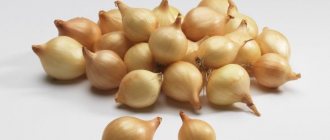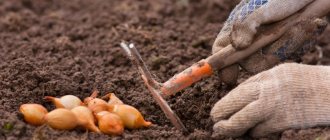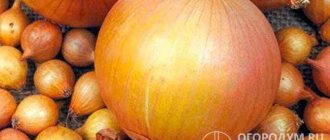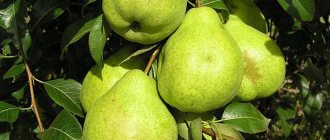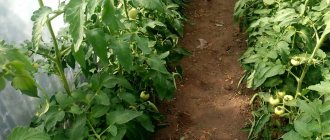June cabbage: description and characteristics
This plant has its own characteristics. Let's take a closer look at the description of the variety here. It is considered the most popular among early ripening varieties among gardeners. Thanks to rapid ripening, you can get a harvest in early summer. The culture has excellent taste properties.
I have been growing this June vegetable for 3 years now. Having planted seedlings in April, I receive fruits in mid-June. Culture matures in groups. The weight of the fetus can reach 2 kg.
From 1 m2 I get a yield of about 6 kg.
I really like the appearance of the June cabbage. A compact rosette of leaves looks quite decent in the beds. The leaves, wavy along the edges, cover the round head of cabbage on top and have a soft green tint. The inner cut is white-yellow. There is quite a decent amount of leaves on one head of cabbage. All of them contain many nutrients and beneficial substances. Vitamin C is present in abundance in cabbage. Overall, the variety is good.
Photo of a bag of seeds with description and characteristics of the variety:
Seedling growing method
In order to get cabbage as early as possible, it is best to use the seedling growing method. In this way, you will protect the plant at a young age from pests and diseases and ensure the formation of full-fledged heads of cabbage with a long growing season.
Preparing seeds for sowing
Seeds sold, as a rule, are already sorted and disinfected and do not require additional processing. If you bought seeds of questionable quality, or use your own material, then it is necessary to carry out pre-sowing preparation.
Against clubroot and other fungal diseases, the seeds are placed for 20 minutes in warm water heated to 50 degrees. The water temperature is maintained at the same level. Then the seeds are placed in cool water for 3-5 minutes and dried thoroughly.
During the disinfection process, floating and small seeds are removed.
There are two ways to grow seedlings: potted and potless. In both cases, sowing seeds can be done with or without further picking.
Pot method
Recently, potted seedlings have been increasingly used. Its advantage is good survival rate, because the root system is kept intact before planting.
If you want to grow early cabbage seedlings without picking, then sowing should be done from late February to mid-March. Preparing the soil for seedlings includes mixing soil and humus in equal parts and adding mineral fertilizers: 30 g of superphosphate, 15 g of potassium nitrate, 10 g of ammonium nitrate per bucket of the mixture. Or any complex fertilizer for cabbage.
As a soil for seedlings, you can use transitional or lowland peat with the addition of sand and sawdust. In the absence of microfertilizers, ash is added to the soil mixture at the rate of 2 cups per bucket.
When the soil for seedlings is prepared, you can start sowing:
- Sow 2-3 cabbage seeds into each container at a depth of 1.5-2 cm in order to select the most successful seedling in the future. After sowing, water the soil generously with water at room temperature. For faster germination of seeds, the pots can be covered with film.
- Maintain the seeded material at a temperature of 25 degrees until seedlings emerge. Then lower the temperature to 8-10 degrees to avoid stretching the seedlings. With the appearance of the first true leaf, raise the temperature to 15-17 degrees during the day and to 10 degrees at night.
- Lowering the temperature at night is necessary so that the seedlings do not grow pampered. Such seedlings do not take root well in the soil. Good seedlings ready for planting in the ground should be stocky and have 4-5 true leaves.
- Keep the soil moderately moist during the growing process to prevent the plant from becoming infected with blackleg. If you discover this disease, ventilate the room and sprinkle the soil with the plant with dry sand. To protect against diseases, add potassium permanganate (3 g per 10 liters of water) to irrigation water.
Potless method
When growing in large volumes or when there is not enough space, use a potless method of growing seedlings. To do this, place the prepared wet mixture in an even layer of 5-6 cm in the boxes and make grooves at a distance of 3-4 cm from one another.
In the phase of 1-2 true leaves, pick the seedlings into pots measuring 6 by 6 cm, or thin out the plants at a distance of 5-6 cm without picking. In potless seedlings, only 10% of the volume of the root system is retained during transplantation.
Potless method with preservation of the root system
There is another way to grow seedlings, which does not involve the use of containers, but it keeps the root system as intact as possible. With this method, pots are formed from well-moistened soil mixture.
To prevent the soil from crumbling when watering, mullein is added to it as a binding material. Its consumption should be no more than 0.5 liters per 1 bucket of mixture. Be careful when preparing this composition, because an excess of mullein will make the soil too dense, which will adversely affect the development of seedlings.
Place the wet mixture in an even layer of 5-6 cm in boxes or directly on the covered soil in a greenhouse, compact it slightly, and then cut along the entire height along and across, forming cubes 6 by 6 cm.
Advantages and disadvantages
“June” cabbage has a lot of advantages:
- Early ripening: only two to three months after planting the seedlings in the soil are enough for the first harvest to appear; Strong leaves, resistant to cracks and damage;
- Watering should be plentiful. Don't be afraid to flood the culture. Even excess moisture has a positive effect on this variety: The forks grow denser and juicier;
- Tender, thin cabbage leaves definitely deserve special attention. They are great for making spring and summer salads.
- Good resistance to low temperatures, as well as temperature changes. The culture can withstand down to -5 degrees. Very resistant to pests.
- Cabbage flies, cabbage pests known to all gardeners, are not dangerous for this variety;
- High yields;
- Culture matures in groups. This is convenient for those who grow it for sale;
- Subtle, delicate taste.
Now a few words about the shortcomings:
- Compared to other cabbage varieties, it is not stored as long as we would like;
- Absolutely not suitable for fermentation or canning. It is impossible to make homemade preparations from it;
- Therefore, the answer to a common question from housewives: “is it possible to salt June cabbage?” - it’s better not to;
- After ripening, the fruits should be harvested at a certain time, otherwise the heads of cabbage may begin to crack.
Photo of June cabbage in the garden:
Plant care
After planting seedlings of the June variety cabbage, you should take proper care of it.
Watering intensity
Cabbage does not tolerate drought. To get a good harvest, it needs to be watered regularly. The soil should be moistened 0.3–0.4 m deep into the ground. The planted seedlings are first watered 3 times every 7 days, maintaining a ratio of 8 liters per 1 m². Then the watering intensity is reduced to once a week based on the proportion of 12 liters per 1 m².
Find out more about how often to water cabbage.
The sprinkling method is best suited for irrigation . Therefore, a nozzle is used for the hose. A drip irrigation system is also great.
Watering largely depends on weather conditions. During heavy rains, it is stopped. But during severe drought, you can moisturize every other day. 14 days before collection, moisturizing is stopped. Don’t forget about watering during the planting period. At this time, in order not to cause cracking of the heads of cabbage, watering is not carried out by sprinkling.
At first, watering should be done at least once a week.
Loosening, weeding
After moistening the soil, the planting area should be loosened to a depth of about 7 cm. During the loosening process, weeds must be removed, which draw moisture and nutrients from the soil.
Important! Planting with cabbage should be hilled. This will help form a strong root system. The first hilling is carried out 3 weeks after planting. Then this process is repeated after 10 days.
Prevention of diseases and pests
Unfortunately, cabbage of this variety can be affected by some diseases and pests. Therefore, in order to get a high-quality harvest, you need to take preventive measures to prevent their appearance. But if infection does occur, then at the first sign it is necessary to quickly take appropriate treatments to save the crop.
Let's look at the main diseases of cabbage:
- Black leg . The area at the base becomes black. The plant crop slows down its growth and development and then dies. The disease can be provoked by thickening of seedlings and moistening with cold water. Plants that are too affected are removed and disposed of. Treatments should be carried out with Fitosporin or 1% Bordeaux mixture.
- Kila. The signs are growths that prevent the roots from developing. Plant growth slows down, the lower leaves begin to dry out. Specimens affected by the disease should be pulled out, and the planting along with the soil should be treated with 1% Bordeaux mixture or the preparations “Hom”, “Tiovit Jeta”. After 7–10 days, the treatment is repeated.
Seedlings can often be affected by clubroot. The disease quickly spreads throughout the entire garden area
- Downy mildew . Excess moisture provokes the disease. Yellow spots appear on the leaves, and a gray coating is found on the bottom. The leaves become deformed and die. Dusting the plantings with ash helps. You should also spray with Fitosporin.
Cabbage can be attacked by the following insect pests:
- Aphid . This small insect drinks the sap of the plant, causing color loss and leaf curling. Moreover, this pest actively transmits various infections and viruses. Treatment with chemicals “Commander”, “Intavir”, “Aktellik” will help. Spraying with infusion of nettle, wormwood or ash-soap solution (300 g of ash, 400 g of soap per 10 liters) also helps.
- Cruciferous flea beetle . It feeds on cabbage leaves, gnawing small holes in it. This leads to the plant drying out. Spraying with chemicals “Karate”, “Aktellik”. Treating with a garlic-soap solution helps a lot.
- Belyanka . Insects, and especially their larvae, quickly eat cabbage leaves and can get to the head of cabbage. As a result, the leaf blades turn yellow and dry out. The caterpillars should be collected and the oviposition removed. For control, treatments are carried out with Fitoverm and Intavir at intervals of 7–10 days.
To prevent the occurrence of pests and diseases, the following measures should be followed:
- in the fall, clear the area of remnants of vegetation;
- dig up the soil before the cold period;
- humidification is carried out by sprinkling;
- the planting area is sprinkled with ash;
- do not thicken the planting;
- follow the rules of crop rotation;
- disinfect seeds. The Immunocytophyte solution is well suited for this purpose;
- carry out soil disinfection before sowing;
- pull out and dispose of diseased specimens;
- Make sure that there is no stagnation of water in the soil.
Did you know? Sulforaphane has anti-cancer effects, and glucosinolates, also found in cabbage leaves, have anti-carcinogenic properties and fight free radicals. This makes cabbage consumption an excellent prevention of cancer.
What to plant next to cabbage
It is no secret to any gardener that all plants need to be placed with the right “neighbors” so that they get along well in the beds and help each other.
It is better to plant cabbage next to such crops as: onions, garlic, dill, radishes, celery, marigolds, chamomile, mint, sage. Various fragrant greens and flowers will repel annoying insects. Lettuce also not only harmoniously coexists with cabbage, but also helps repel the flea beetle.
Undesirable companions for cabbage, including June cabbage, will be tomatoes and carrots.
Video on the topic:
Planting cabbage in open ground
Cabbage, like most plants, grows best with a square planting method, when the row spacing is equal to the planting spacing.
However, for ease of care, many gardeners plant cabbage in one row spacing 60-70 cm wide. With this method of cultivation, the planting step for early ripening cabbage is 30-35 cm. If you are late in planting seedlings or your plot is low-fertile, you need to increase the row spacing to 80 cm and plant cabbage less often.
The next steps look like this:
- form holes 10-12 cm deep;
- add a handful of humus and 2 tablespoons of ash or mineral fertilizers to each hole according to the instructions;
- thoroughly pour at least 2 liters of water into the holes;
- if the seedlings were grown using a potless method, before planting, dip its roots in a liquid solution of clay and mullein;
- when planting plants, deepen the root collar 2-4 cm to the first leaf, but do not cover the apical bud;
- squeeze the soil around the cabbage, water it and sprinkle it with dry soil so that a crust does not form;
After planting, it takes 10-14 days for rooting. At this time, the seedlings have reduced frost resistance, so a film shelter needs to be built over them.
About growing early cabbage - from planting seedlings in the ground to harvest - watch the video:
Pests and diseases of cabbage
June white cabbage, like any vegetable crop, is exposed to a huge number of pests and diseases and requires appropriate control measures.
Among the diseases are:
Clubroot is the formation of growths on roots that prevent the growth of young roots. In this case, it is recommended to remove diseased plants and carry out disinfection. Do not grow crops in this place for 4 years;
Fusarium wilt is characterized by yellowing falling leaves. The result is just a barrel with a rosette on top. Culture stops growing. With this disease, diseased plants are removed along with the soil;
The black leg is the neck of the root, the stem begins to rot, and the plant dies. All that can be done in this case is to burn the plant and disinfect the soil.
Common pests include:
Cruciferous bugs. They harm the crop by sucking the juice of the leaves. They must be combated using chemical methods.
Aphid. By attacking a plant, it disrupts the metabolic processes inside it. This affects the condition of the entire plant. In this case, processing is also required.
Ground flea beetles and cabbage flies.
The caterpillars of all the butterflies in the world simply adore cabbage.
Ways to control cabbage pests.
It is not customary to spray early cabbage with insecticides. This procedure is indicated only for late species. Therefore, you can be content only with folk remedies and methods.
For caterpillars and aphids, you can use a solution based on ash and soap.
You need to take 3 tablespoons of ash in a three-liter jar, steam it with boiling water and leave it to steep overnight. Next, you need to strain this folk remedy and add a few drops of soap to it. Treatment (spraying) should be carried out as early as possible in the morning. After 1-2 days, spraying the cabbage should be repeated.
Photo of caterpillars who love delicious cabbage leaves:
Features of planting and growing
Seeds are planted on seedlings to obtain healthy heads of cabbage in late February or early March. After two months, the plants are transplanted into open ground.
Preparing for landing
The soil mixture for sowing is prepared in the fall. To do this, mix peat, humus, sand and ordinary soil (1:1:1:1) from the garden.
Seed preparation
Before sowing, the seeds are heated in hot water +40°C for about 15 minutes. Those that have settled and floated are removed. After this, the seeds are immersed in cool water for five minutes.
Preparing seedlings
For strong seedlings, picking is carried out 1-2 weeks after emergence. Containers for seedlings, in order to reduce possible injuries to young roots, are 5x5 cm in size. In order for seedlings to grow and develop better, you can use fluorescent lamps, which illuminate the seedlings for 10-14 hours a day.
Planting cabbage seeds of the June variety for seedlings
How to plant without seedlings
Sowing is best done in early spring, when the soil is well saturated with water due to rain. Sowing is done mechanically, using a vegetable seeder, or manually. After the seeds are sown in the holes, the soil is mulched with sawdust or humus.
Attention! For mechanized sowing, dry superphosphate should be added to the seeds. This will ensure uniform seeding throughout the garden and will have a positive effect on the formation of roots.
Soil requirements
The soil for sowing June cabbage is chosen the same as for other types of early ripening cabbage. The best option is soil with a fine-lumpy structure with an acidity (pH) of 5.5-6.0.
Predecessors
The best predecessors for June are crops that were well fertilized. The early-ripening June variety is best planted in beds where onions, potatoes, carrots, zucchini, peas, and beans were previously sown. The crop is not planted after other cabbages: rapeseed, radish, horseradish, mustard, etc.
Dates, schemes and planting rules
Seedlings are planted in early March according to a 45x60 cm pattern. The planting density is usually indicated in the instructions of the seed manufacturer. To ensure optimal water-air balance, an inter-row cultivation procedure is carried out using cultivators to avoid injury to the crop. Finger tools are also used; they work not only between rows, but also the ground between plants. During cultivation, mineral fertilizers are applied.
Planting density and depth
The optimal sowing depth for grown June seedlings is 5-10 cm. The distance between neighboring plants in a row is from 40 to 60 cm.
Features of cultivation
To grow large and healthy cabbage heads, it is necessary to comply with all agrotechnical requirements: regularly weed and loosen the garden soil, feed the plants with various fertilizers and water them in a timely manner.
The variety is easy to care for, so following the simple recommendations of experienced farmers, you can reap an excellent harvest.
Watering mode
Water the cabbage once every 1-2 days. Water consumption is about 8 liters per 1 sq. m. The correct watering regime stimulates the full growth of the rosette. For irrigation, it is better to use settled or rainwater. During the growth of the rosette, water the soil moderately. If the soil is waterlogged, this will lead to stunted growth and possible death of the crop.
Loosening and hilling
The first loosening is carried out when the seedlings planted in open ground have grown and become stronger. Loosen with a hoe, a flat cutter, or a hand cultivator. The loosened holes are covered with earth, the surface of the bed is leveled, while the stems are left a little hilled up. The soil is loosened again at the end of May, and small mounds are made on the surface of the soil.
Top dressing
The first feeding is carried out 7-9 days after picking. To feed growing seedlings, make the following solution:
- potash fertilizers 2 g;
- ammonium nitrate 2 g;
- 4 g superphosphate;
- 1 liter of water.
After two weeks, the procedure is repeated, but a double portion of fertilizer is taken per 1 liter of water. The third time the nutritional composition is applied shortly before planting the seedlings in the garden. For 1 liter of water take 3 g of ammonium nitrate, 8 g of potassium compound, 5 g of superphosphate.
Important! For better development of cabbage heads, you can add rotted manure to the soil.
Measures to increase yield
To increase the yield of June, it is recommended to purchase high-quality seeds, choose optimal soil with low acidity and carry out the necessary agrotechnical measures in a timely manner: watering, loosening, hilling the soil, applying special fertilizers.
Disease and pest control
June cabbage can be affected by common fungal diseases such as blackleg and clubroot. Having identified the first signs of the disease, remove the affected plants and add a solution of copper sulfate to the soil for disinfection.
Among insects, June cabbage is often affected by cruciferous bugs, aphids, flea beetles, and caterpillars of cabbage butterflies.
Important! Early ripening cabbage varieties cannot be treated with insecticides. An effective alternative to insecticides will be folk remedies: tobacco dust and an aqueous solution of liquid soap, which is sprayed on plants.
Difficulties in growing
If all agricultural requirements are met, growing June is not a troublesome task. This cabbage can be affected by fungus and garden insects, which can be easily corrected with the help of special biological products “Planriz Tirama” and “Baktofit”.
Harvesting and storage rules
Cabbage "June" has good yield. Fully ripens by the end of June. In the southern regions of the country - in early June.
In accordance with the detailed description of the June cabbage variety, the heads of cabbage ripen in groups at the end of the first month of summer - in June. Two months after planting in open ground. You can understand that it is time to harvest by focusing on external signs. A solid head of cabbage of the required size can be safely removed from the garden bed.
Attention! Another important sign that the crop is ready for harvest is the yellowing of the outer leaves of the head of cabbage in the lower part. This means that the fruit will no longer grow and can be removed from the garden.
The best time for collection is early cool morning, without high humidity. It is better to choose dry weather. The fruits should be cut carefully, leaving a two-centimeter stalk and three leaves on the bed.
It is better not to delay harvesting. I have already spoken about this above and I will remind you again: when ripe heads of cabbage are delayed in harvesting, they begin to crack. Storage – maximum two weeks (short-term shelf life). June cabbage ripens early and its harvest is recommended to be consumed fresh.
Photo of June cabbage harvest:
Reviews
Reviews about June cabbage are most often laudatory. But with incorrect agricultural technology, this relatively unpretentious variety can cause a lot of trouble. Judge for yourself.
Olga, Vinnytsia region
I like the June one. Grows quickly and requires minimal care. But through experience, I realized that this cabbage needs a lot of light. Even the slightest shading can lead to stunted growth.
Lyudmila, Rostov
This cabbage helps us out all summer. When it ripens, we do not remove it from the garden. Poorly stored. But it stands on the ground and does not crack. Just don't need to water anymore. A very tasty variety both fresh and in borscht and casseroles. It's literally ready in a moment. Until it ripens later, we only eat it. I recommend!
Vladimir, Penza
Last year I planted June cabbage - I fell for the description. But I didn't like this variety. The heads of cabbage grew small and loose. True, it rained infrequently, but you still expect more from a good variety. And so they started eating it only in July. Although the taste is very good. But there are better early varieties, or rather hybrids.
My opinion about the June cabbage variety
Overall, I like the June cabbage variety. After reading numerous reviews on the Internet and looking at photos of healthy, beautiful, round heads of cabbage, I decided to allocate a small space in my garden for this crop. And for many years now, June cabbage has pleased us as one of the first among other varieties. The harvest can be harvested 2 times. To do this, cut off the head with a sharp knife, leaving at least 2 leaves on the stalk. To get a second harvest, you must not break off the leaves of the rosette.
It really ripens very quickly. Requires minimal care compared to other crops. It is only necessary to water and fertilize in a timely manner. Planting seedlings is simple. Growing June cabbage is not a difficult process. The variety is productive. From 1 m2 I managed to get about 6 kg of fruit.
Some consider the disadvantages that cabbage does not last long and is not recommended for use for winter preparations. This is likely true. But each variety has its own pros and cons. If you want to start pleasing yourself and your loved ones with fresh cabbage as early as possible, then this variety may become one of your favorites. The culture has a wonderful, juicy taste. It is good for making fresh summer salads.
The high content of ascorbic acid, low amount of kcal, as well as many other beneficial properties make it stand out from other vegetable crops.
I recommend this variety for planting, including for beginning gardeners. The culture is worthy of attention. I plan to grow it next season as well.
How to care
June white cabbage responds positively to moisture. But just make sure that the soil is not too dry or too wet. The plant will need to be watered 2 times a week. But before harvesting, watering will have to be reduced. Approximately 10 liters of water will be needed per 1 m2.
Top dressing
As soon as 7-9 days have passed since the picking, the time has come to apply the first fertilizing. To do this, you need to prepare the following components:
- potash fertilizers – 2 g;
- superphosphate – 4 g;
- ammonium nitrate – 2 g;
- water – 1 l.
The prepared solution should be enough for 5 seedlings.
The second time it is necessary to apply fertilizer 14 days after the first. To do this, use all the same components, but only in double quantities, and the amount of water is the same. If you find that the leaves have begun to turn yellow, then you need to add fermented manure - 1:10. The third feeding involves the use of the following ingredients:
- ammonium nitrate – 3 g;
- potassium compounds – 8 g;
- superphosphate – 5 g;
- water – 1 l.
Pests and diseases
Clubroot remains the most dangerous disease for June cabbage. This disease is of fungal origin. It damages early varieties of cabbage. There is no ovary on the root system of the seedlings. To combat the disease, it is necessary to remove all affected plants with a clod of earth from the site. And sprinkle the place where the bushes grew with lime. Next time you shouldn't grow kaputa there.
Cabbage can often be affected by blackleg in the seedling stage. This is another fungal disease that attacks the root collar at the base of the stem. As a result, they become black, thin and rot. It is necessary to remove the affected plant and replace the soil on the site, since nothing else can be grown on it.
Maybe
Description and characteristics of the white cabbage variety “Iyunskaya” from the manufacturer Gavrish
Early ripening (up to 117 days from germination to technical ripeness) variety. Sowing seedlings in early March. Picking in the cotyledon phase. Planting in the ground at the end of April (under film covers) - beginning of May according to the 50x30 cm pattern. From planting seedlings to harvesting 44-55 days. The rosette of leaves is small, compact, 40-50 cm in diameter. The head is round, light green, weighing 0.8-1.2 kg, medium dense.
The outer color is light green, when cut it is white-yellow. The taste is excellent. The variety is characterized by high productivity and good commercial qualities of heads of cabbage. Recommended for fresh consumption. Productivity 2.3-3.7 kg/m2.
Reviews of June cabbage can be left by any gardener who wants to share his experience.
The best varieties for growing in Russia
Its benefits, unpretentiousness and productivity helped the vegetable spread in many European countries, but in Russia there are not many gardeners growing the crop. Despite this, there are several varieties recommended for cultivation in certain regions of the country. The presented varieties are resistant to pest attacks and diseases and are undemanding to care.
Early ripening varieties with a growing season of 65 to 80 days can be grown in all regions of Russia.
From a fairly large list, the following stand out:
- "Viennese white" Suitable for cultivation in open ground and equipped greenhouses. The fruit is tasty, the flesh is white and juicy. The yield is increased, so the plants are grown commercially;
- “Prague white” is a flat-round, small, green fruit. Taste is the advantage of the variety. The disadvantage of the plant is that the crop cannot be stored for a long time;
- “Sonata” (hybrid) is an ultra-early ripening variety that fully ripens in 2 months. The fruits are spherical, rich purple in color;
- “Athena” is a Czech variety with good taste. The weight of the fruit is small, rarely exceeding 250 g;
- "Moravia" is a frost-resistant variety. The taste of the pulp is soft but rich. The weight of the head is about 2 kg, but the variety is unsuitable for storage.
Experienced gardeners recommend using early-ripening crops within several months after harvest. For long-term storage and preparation, it is better to grow mid-season or late varieties.
The list of varieties with good taste includes:
- "Madonna";
- "Viennese blue";
- "kartago";
- "optimus blue";
- "Violet";
- "delicacy white";
- "hummingbird";
- "giant".
Understanding the ripening period of a particular variety is quite simple. Most early varieties of kohlrabi have a white fruit color, while late and middle varieties are purple.
Description of the early variety
June cabbage is considered a variety with a long history. Its breeding was announced more than 50 years ago. By 1971, the culture passed all the necessary tests and was included in the official list of the State Register of Russia.
The bushes look neat, since the leaf rosette barely reaches 50 cm in diameter. Cabbage has a short but clearly visible outer stalk. Inside there is a stump of average parameters. The upper leaves are a pleasant light green color, the wax coating is not intense, but clearly visible. The inside of this cabbage variety is cream or yellowish-white.
The photo shows that the cabbage is small in size. The average head of cabbage grows up to 2 kg. The head resembles a round smooth ball.
| View | White cabbage |
| Head of cabbage, stalk | Round, dense. Internal - average, external - average |
| Fetal weight | 1.5 – 2.5 kg |
| Planting scheme | 60x60 cm |
| Ripening period | Early ripening (90 – 100 days) |
| Drop off point | exhaust gas/greenhouse |
| By type of use | Salad |
| Diseases | Resistance to cabbage fly |
Plant with seeds or seedlings
- Preparing the beds. At the beginning of May, plant cabbage seedlings in open ground on the prepared beds after the phacelia. The plant prefers neutral, well-deoxidized soil. You can first add wood ash or dolomite flour to the ground. It is also good to add organic fertilizers to the soil in the fall for early feeding of cabbage.
- Landing. Plants should be planted at a distance of 50 cm from each other in a checkerboard pattern. First make a hole in the ground and pour it well with warm water. Then carefully place the sprout with the root ball of soil in the hole and sprinkle with soil. After planting, the plant must be watered abundantly and shaded with agrofibre.
- Pest control. Early plantings are often attacked by the cabbage fly. To combat the pest, an infusion of tomato leaves and garlic arrows mixed with a soap solution is used. It is good to additionally sprinkle the leaves with tobacco flour and wood ash. During the period of active growth, do not forget to water the cabbage generously and hill up after each moistening.
Video: Valery Medvedev’s channel tells how to plant and care for June cabbage.
How and when to plant
June cabbage is grown by seedlings and without seedlings.
Seedling method
The first step is to prepare the planting material and the soil itself.
Land preparation
To plant cabbage, you must use only fertilized soil. At the same time, it is better to prepare it in advance. For these purposes, add humus or ash to the soil. The last component will be an excellent antiseptic that will prevent the development of rotting. The ground must be breathable. It is also worth learning more about how far apart early white cabbage should be planted.
Seed preparation
Before planting, the seeds must be treated to create complete protection against unwanted infection. For these purposes, pour the planting material with lightly salted water and leave for 20 minutes. After this, rinse the grains under running water and dry thoroughly.
Landing
Fill the wooden box with the prepared substrate. Make beards 1 cm deep. Place the seeds, keeping a distance of 3 cm between them. Cover with soil and water lightly. Place glass or film on top. Keep seedlings at a temperature of 13-15 degrees.
When growing seedlings, you need to take care of their regular lighting. For this you will need to use additional devices. A fluorescent lamp would be an excellent option. Plants need to be illuminated for 15 hours.
And although June cabbage is moisture-loving, you should not overwater it. Moisturize as the top layer dries.
Picking
As soon as the first shoots form, they need to be thinned out. The next picking is carried out after 2 months. Then the plants are planted in separate cups.
Hardening
In order for cabbage bushes to take root as quickly as possible, it is necessary to harden them off before planting. This must be done 7 days before the upcoming planting. To do this, the container with seedlings is taken outside and allowed to gradually get used to the sun. Just make sure that the seedlings do not get direct sunlight, as they do not like it. But what are the best varieties of Chinese cabbage, what does it look like, are described here.
Transplant to open area
You can plant seedlings in open ground after small leaves have formed on them. At first, you need to take care of protecting the seedlings from sunlight. The presented variety of cabbage grows well in any conditions, but it will not tolerate strong fat.
In the video - planting June cabbage:
Planting seeds in open ground
You can plant June cabbage directly in an open bent with seeds. It is worth preparing holes for it, placing them at a distance of 25 cm. Plant the planting material to a depth of 2-3 cm. Cover with earth, compact and water. As soon as the first shoots were discovered, weed the plant.
Transplanting seedlings into the ground
The quality of seedlings and timely transplantation into the garden bed largely determine the future harvest of vegetables.
Disembarkation dates
By the time of planting, the seedlings should grow to 10–15 cm, develop 2–3 pairs of true leaves and prepare for life in new conditions. In the central regions, hardened seedlings are transplanted to the site from April 20 to May 15, as soon as prolonged warmth has established (15°C). Plants will withstand even a short-term drop in air temperature to -3°C in the morning. However, if it is still cold not only at night, but also during the day, the landing will have to be postponed until it warms up. In the south of the country, transplanting to a garden bed is carried out in early April, in the north - at the end of May - beginning of June.
Seedlings ready for planting in the ground should have 2 pairs of true leaves.
Scheme of planting early-ripening cabbage seedlings on the site
For cabbage, choose a well-lit area, dig it up, add 100 g of superphosphate per m2, a bucket of humus, and if the soil is highly acidified, add 500 g of lime or ash. The culture grows well on loose loamy soil after potatoes, carrots, onions, cucumbers, pumpkins and legumes. White cabbage is grown in rows. Mark rows on the ridge, make holes and moisten them by adding 500 ml of water to each. Seedlings of early ripening varieties are planted in a bed according to a 60x35–40 cm pattern.
White cabbage is grown in a row according to a 60x40 cm pattern.
The seedlings are removed from the container without shaking off the soil and placed in the hole. Sprinkle down to the cotyledon leaves and cover with non-woven material for 2-3 days to protect from too active spring sun or night cold snaps.
Agrofibre is stretched over the bed with planted seedlings on arcs to protect from the sun and cold weather
Video: planting early cabbage in open ground
Early cabbage, unlike mid- and late-ripening varieties, is not grown by direct sowing into the ground. Vegetables at the beginning of summer can only be obtained using the seedling growing method. Cabbage seedlings are not difficult to grow even for inexperienced gardeners, especially if you listen to the advice of experienced gardeners.

